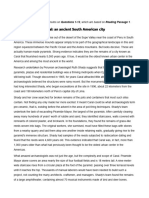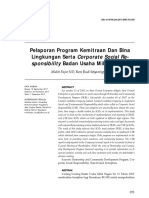READING PASSAGE 1
You should spend about 20 minutes on Questions 1-13, which are based on Reading Passage
1 on pages 2 and 3.
The Importance of Business Cards
The exchanging of business cards is as close to a universal ritual as you can find in the business
world
The ritual may be universal, but the details of business cards and how they are swapped vary
across countries. Americans throw their cards casually across a table; the Japanese make the
exchange of cards a formal ceremony. While there are cards that are discreet and understated,
others are crammed full of details and titles. Some business people hand out 24-carat gold
cards, and there are kindergarten children who have cards with not only their own contact details
but also with the job descriptions of their parents and even grandparents. This practice has
become so common in parts of New York, for example, that the use of such cards is now
prohibited by some of these institutions.
Cards have been around a long time in one form or another. The Chinese invented calling cards
in the 15th century to give people notice that they intended to pay them a visit, but these were for
social purposes only. Then, in the 17th century, European business people invented a new type
of card to act as miniature advertisements, signaling the advent of the business card. In today’s
world, business cards can cause people to have strong emotional reactions. According to one
experienced company director, very few things can provoke more heated discussion at a board
meeting than the composition of the company’s business cards
Lots of companies try to promote themselves by altering the form of the card. Employees at one
famous toy company give out little plastic figures with their contact details stamped on them. One
fast food company has business cards which are shaped like a portion of French fries. A
Canadian divorce lawyer once gave out a card that could be torn in two — one half for each of
the spouses. For many business commentators, such gimmicky business cards prove that the
use of a physical business card is nearly at an end. After all, why bother exchanging bits of thick
paper at all when you can simply swap electronic versions by smartphone.
However, one can just as well argue the opposite: that business cards are here to stay, and in a
business world full of meetings and correspondence, it is more important than ever that your card
is unique. Attempts to reinvent business cards for the digital age have not been successful. Even
at the latest technology conferences, people still greet each other by handing out little rectangles
made from paper rather than using a digital alternative.
To understand business cards, it is necessary to understand how business works. That business
cards are thriving in a digital age is a forceful reminder that there is much about business that is
timeless. According to Kate Jones, a business lecturer, there is one eternal and inescapable
issue. Her 2006 study of more than 200 business executives in North America found that trust
was the key element for running a successful business. It is vital to be able to look someone in
the eye and decide what sort of person they are.
�In this way, you can transform acquaintanceship into relationships. A good proportion of business
life will always be about building social connections — having dinner or playing sport with clients
and colleagues — and while computers can deal with administrative tasks, it is human beings
that have to focus on the emotional.
The rapid advance of globalization means that this relationship-building process is becoming
ever more demanding. Managers have to put more effort in when dealing with international
counterparts, especially when there is not a common language, which is so often the case these
days. A recent UK survey showed that chief executives of global organizations now routinely
spend three out of every four weeks on international travel. It is in these situations that business
cards are doubly useful, as they are a quick way of establishing connections. Cards can also
remind you that you have actually met someone in a face-to-face meeting rather than just
searched for them on the internet. Looking through piles of different cards can enhance your
memory in ways that simply looking through uniform electronic lists would never do.
Janet McIntyre is a leading expert on business cards in today’s world. She maintains that as
companies become more complex, cards are essential in determining the exact status of every
contact you meet in multinational corporations. Janet also explains how exchanging business
cards can be an effective way of initiating a conversation because it gives people a ritual to follow
when they first meet a new business contact.
The business world is obsessed with the idea of creating and inventing new things that will
change the way we do everything, and this does lead to progress. But there are lots of things that
do not need to be changed, and in Janet McIntyre’s view, tradition also has an equally valuable
role to play. Therefore, the practice of exchanging business cards is likely to continue in the
business world.
�Questions 1 - 5
Do the following statements agree with the information given in Reading Passage 1?
In boxes 1 -5 on your answer sheet, write
TRUE if the statement agrees with the information
FALSE if the statement contradicts the information
NOT GIVEN if there is no information on this
1. Children's business cards have been banned in some kindergartens.
2. It was the Chinese who first began the practice of using business cards.
3. Designing business cards can be a controversial process for some companies.
4. A famous toy company has boosted its sales by using one type of unusual business
card.
5. Some business commentators predict a decline in the use of paper business cards.
� Questions 6-13
Complete the notes below.
Choose ONE WORD ONLY from the passage for each answer.
Write your answers in boxes 6-13 on your answer sheet.
How business works
Kate Jones’s research
• The most important aspect of business is having 6............... in others.
• 7 ................ do not have the ability to establish the good relationships essential
to business.
Business and globalisation
• Managers must work harder when they don't share the same 8.............. with
their contacts.
• AUK sun/ey indicates that 9................ takes up the largest part of business
leaders’ time.
• A business person's 10.............. of a meeting can be improved by looking at
business cards.
Janet McIntyre
• Business cards clearly show the 11............... of each person in a large company.
• The ritual of swapping business cards is a good way of starting a 12..................
at the beginning of a business relationship.
• Janet feels that in the business world, 13.................. is just as important as
innovation.
�READING PASSAGE 2
You should spend about 20 minutes on Questions 14-26, which are based on Reading
Passage 2 on pages 6 and 7.
Questions 14-19
Reading Passage 2 has seven paragraphs, A-F.
Choose the correct heading for each paragraph from the list of heading below.
Write the correct number, i-viii, in boxes 14- o19n your answer sheet.
List of Headings
i Opposition by employers to parental leave
ii An illustration of a trend in one country
iii An explanation for the limited success of government initiatives
iv Pressure for change from an unlikely source
v The need for cooperation at a global level
vi The contrast in attitudes towards leave for mothers and fathers
vii A range of measures to encourage more equal responsibility
viii The implications of maternity leave
14 Paragraph A
15 Paragraph B
16 Paragraph C
17 Paragraph D
18 Paragraph E
19 Paragraph F
� Paternity Leave
Men have long been discouraged from playing an equal role at home. That is at last starting
to change
A At a course for fathers-to-be in New York, participants are introduced to baby
maintenance for beginners: how to keep their babies fed, warm and clean. The City Dads
Group was founded when Matt Schneider and Lances Somerfeld became fathers and
discovered that people saw their place as firmly outside the home. New York was full of
parents' support groups, but nearly all were aimed at mothers. Frustrated, the friends set up
their own group, which has spread to 17 cities in the USA, helping fathers who want to get
involved from day one.
B In general, legal and financial support for new parents is better than it has ever been.
According to the International Labor Organization (ILO), 85% of countries now provide at
least 12 weeks' maternity leave. In all but two of the 185 countries it surveys, mothers are
entitled to some leave paid for by the state, companies or some combination of the two.
Although only a third of countries meet the ILO's recommended minimum of at least 14
weeks off for new mothers, paid at two-thirds their salary and funded publicly, the picture is
improving.
But how many countries meet the ILO's guidelines on paternity leave? None because no
such guidelines exist. Though it published detailed advice regarding female employees, the
organization has drawn up no formal recommendations on fathers' rights and duties. Until
recently, national governments have been similarly uninterested; less than half of countries
offer paternity leave of any sort. Only around half a dozen offer new fathers more than a
fortnight, and companies, not the state, usually foot the bill for the costs of paternity leave.
In the eyes of most people, responsibility for bringing up baby still falls squarely on the
mother.
C Now a different view is slowly emerging, as growing evidence suggests that children
benefit from seeing more of their fathers. But much of the demand for a shift in approaches
to childcare has come from women, who have started to conclude that they are victims as
well as beneficiaries of generous maternity-leave policies.
D This may appear paradoxical, as most countries have found that when they offer decent
maternity leave, they increase female employment. If women have no right to take time off,
or are entitled only to short or poorly paid spells of absence, many have little choice but to
leave the workforce when their baby is born. If they can take a few months of paid leave
before returning to their old job, they are more likely to continue working. But it turns out that
long maternity breaks have unintended consequences. Time away from the labour market
reduce women's earning power, as their skills degrade and they miss chances to gain
experience and win promotion. Moving into senior management becomes particularly hard,
partly because of discrimination by bosses and hiring committees, who reject candidates
they think may be away a lot, and partly because many high-level jobs are hard to combine
with serial leave-taking. And the effect is magnified when lengthy maternity leave is
combined with policies to encourage part-time work, which tempt more women back into the
labour force but keep them in junior position.
�E Rather than simply cutting maternity leave in response to such findings, a growing
number of governments are trying to spread the child-rearing burden (or joy, depending on
how one looks at it). Britain recently became the latest country to combine maternity and
paternity leave into a single chunk of parental leave, to be split between mother and father
however they see fit. Several European countries, as well as Australia and New Zealand,
already have such a system.
The problem is that dads tend not to take up the offer. In Austria, the Czech Republic and
Poland, where all parental leave is transferable, only about 3% of dads make use of it. In
Britain, the government estimates that 2-8% of dads will take more than their existing
fortnight.
The main reason for low take-up by fathers is financial: even pre-childbirth, women are paid
less than men, meaning that their salaries are easier to forgo during a period of unpaid or
low-paid leave. But pressure related to culture also weigh heavily. Mothers still tend to be
seen as the main carers, with dads portrayed in domestic terms as blundering sidekicks or
well-meaning buffoons.
F To overcome these obstacles, some countries are giving fathers a firm nudge. In a few,
including Chile, Italy and Portugal, paternity leave is compulsory. Others offer incentives
that are hard to turn down. Sweden grants a bonus to parents who share leave more
equally.
Swedish fathers now account for more than a fifth of all parental leave taken, compared with
almost none when shared leave was introduced. Germany introduced the same system and
saw the proportion of fathers taking time off rise from 3% in 2006 to 32% in 2013, and
Poland has switched to gender-specific quotas, replacing the previous system of shared
leave.
Where leave is well-paid and not seen as 'belonging' to the mother, fathers seem willing to
request it. State meddling in what has historically been regarded as a natural division of
labour may annoy some people. But traditional maternity leave, which channels men into
breadwinning and women into child-rearing, is hardly neutral. And shared involvement by
parents stands to improve women's careers, children's development and perhaps even
dads' life satisfaction.
�Questions 20-21
Choose TWO letters, A-E
Write the correct letters in boxes 20 and 21 on your answer sheet
According to the writer, which TWO problems may be caused by maternity leave?
A women may be less effective at work after maternity leave.
B women may find it difficult to find suitable part-time work
C women may find they are paid less for doing the same work
D women’s chances of professional advancement may be effected
E women’s pay may be insufficient to support them during maternity leave.
Questions 22-26
Complete the summary below.
Choose ONE WORD ONLY from the passage for each answer.
Write your answers in boxes 22-26 on your answer sheet.
Encouraging more fathers to take paternity leave
Even in countries where paternity leave is easy to get, few fathers make use of it, chiefly for
22 ________ reasons. However, issues connected with 23 ________, including traditional
views of male and female roles in the family, may also play a part.
Some countries, such as Chile, have made it 24 ________ for men to take paternity leave.
Sweden and Germany both offer a bonus to families where parents share leave, and in
Poland, mothers and fathers each have 25 ________ of leave which are specified for them.
Sharing children in this way may be good for both mothers and fathers, and may also
support the 26 ________ of the child.

























































































